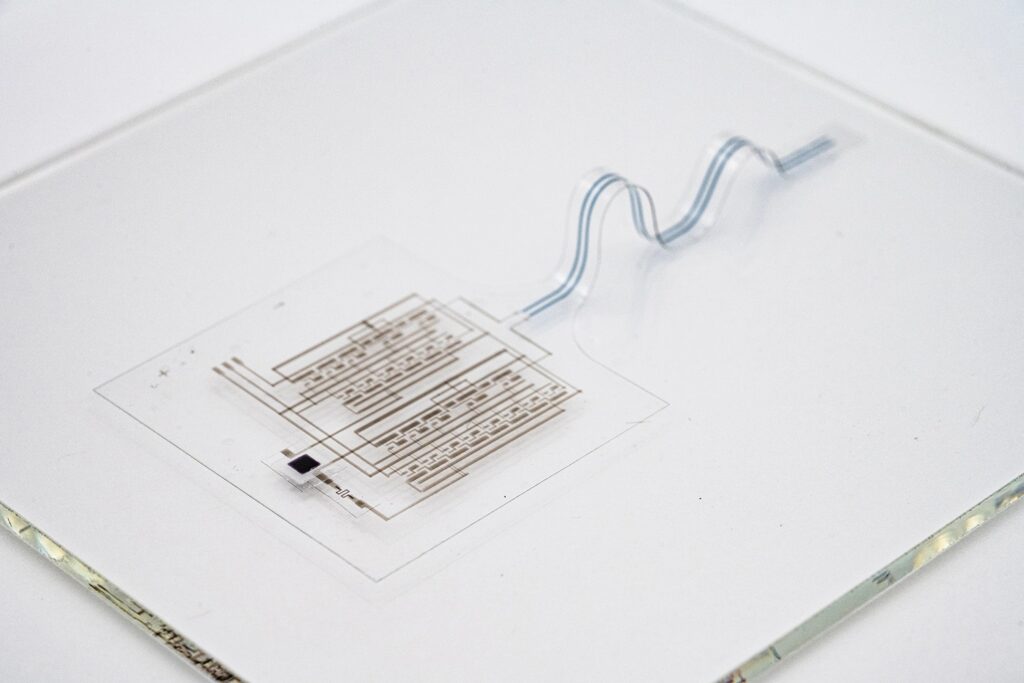The remarkable potential of Soft’s skin lies in its ability to generate nerve-like impulses that establish a direct line of communication with the brain.
This study investigates the mechanisms and implications of this ground-breaking technology, shedding light on its transformative impact on neurocommunication.
By stimulating natural nerve signals, the Soft ‘e-skin’ holds promise for advancing areas such as prosthetics, human-machine interfaces, and neuroscientific research. Understanding how this innovative interface interacts with the brain is crucial to unlocking its full potential for enhancing human lives.
Human skin’s mechanoreceptors possess an incredible ability to sense various stimuli, such as the light weight of a butterfly, the warmth of a flame, the coolness of a drink, and even differentiate between different hand gestures or feel a loved one’s pulse with a gentle touch.
While engineers have successfully developed flexible materials that replicate these senses, they have not yet achieved a single sheet of artificial electronic skin that can directly communicate with the brain—until now.
Researchers at Stanford University have made a significant breakthrough by creating soft integrated circuits within the electronic skin. These circuits can convert sensed pressure or temperature into electrical signals that resemble nerve impulses.
This advancement eliminates the need for rigid electronics in previous attempts to translate sensory information into brain-readable electrical pulses.
The ultimate goal is to direct these signals to wireless communication chips implanted in peripheral nerves, enabling amputees to control prosthetic limbs. Moreover, this technology holds potential for various medical applications, including implantable or wearable devices, in the future.
“We’ve been working on a monolithic e-skin for some time. The hurdle was not finding mechanisms to mimic the remarkable sensory abilities of human touch, but bringing them together using only skin-like materials.” said Zhenan Bao, K.K. Lee Professor in Chemical Engineering and senior author of the study appearing in Science.
“Much of that challenge came down to advancing the skin-like electronic materials so that they can be incorporated into integrated circuits with sufficient complexity to generate nerve-like pulse trains and low enough operating voltage to be used safely on the human body.” said Weichen Wang, a doctoral candidate in Bao’s lab, who is a first author of the paper. Wang has been working on this prototype for three years.

The researchers from Stanford University aimed to develop a soft integrated circuit that could replicate the functions of sensory receptors and operate efficiently at a low voltage. Their initial attempts required high voltages and lacked sufficient circuit functionality. However, they succeeded in creating a new electronic skin (e-skin) that runs on just 5 volts and can detect stimuli similar to natural skin.
The e-skin consists of three layers containing networks of organic nanostructures that can transmit electrical signals even when stretched. These networks can be designed to sense pressure, temperature, strain, and chemicals.
This advancement in e-skin technology is crucial for future prosthetic limbs that restore movement and provide sensory feedback, allowing users to control the devices more precisely. The e-skin material is highly stretchable and maintains its nerve-like electrical characteristics over time.
The innovative tri-layer dielectric structure in the e-skin significantly enhances the mobility of electrical charge carriers, enabling the circuits to operate effectively at low voltage. One of the layers in the tri-layer structure is made of nitrile, the same material used in surgical gloves, while the remaining layers consist of multiple skin-like materials.
Each sensory input type requires an integrated circuit to create the electronic skin. These circuits are then carefully combined into a single monolithic material to ensure it remains intact without delaminating, tearing, or losing its electrical function. Each electronic layer is skinny, measuring only a few tens to a hundred nanometers.
To facilitate easier handling, a substrate is used to support the layers, bringing the overall thickness of the e-skin to around 25-50 microns, comparable to the thickness of a sheet of paper and similar to the outer layer of human skin.
The recent breakthrough in creating a soft, durable electronic skin has paved the way for next-generation advancements. This innovative system combines sensory capabilities with human skin’s desired electrical and mechanical features. It holds tremendous potential for use in future prosthetic skins and cutting-edge human-machine interfaces, enabling a more realistic sense of touch.
With their prototype successfully developed, the team led by Bao and Wang now focuses on enhancing the complexity and scalability of the technology. Their goals include incorporating wireless functionality, establishing interfaces with the brain, and expanding connectivity with the peripheral parts of the body.
This breakthrough technology enables the creation of artificial electronic skin that mimics the functionalities of human skin while operating at low voltages. By incorporating a tri-layer dielectric structure and networks of organic nanostructures, the e-skin can sense various stimuli, such as pressure, temperature, strain, and chemicals.
The successful integration of this soft e-skin paves the way for advancements in prosthetics, human-machine interfaces, and wearable medical devices. Further research aims to enhance complexity, scalability, and wireless functionality and establish interfaces with the brain and peripheral systems. This opens up new possibilities for improved sensory feedback and control in future applications.
In conclusion, developing a neuromorphic sensorimotor loop embodied by monolithically integrated, low-voltage, soft e-skin marks a significant milestone in the field.
Journal Reference:
- Weichen Wang , Yuanwen Jiang,et.al. Neuromorphic sensorimotor loop embodied by monolithically integrated, low-voltage, soft e-skin. Science. DOI: DOI: 10.1126/science.ade0086
